It’s a crisp, grey morning in July. Waves crash onto the shelf of pebbles that make up a newly formed stretch of beach in Folkestone, shingle dredged from the harbour. Across it snakes a boardwalk made from railway sleepers.
Five storeys above, I stand in a Shoreline Crescent showroom apartment – the penthouse – which looks over the sea below across an undulating terrace, which wraps around a third of this new building’s perimeter. With just two bedrooms and a starting price of £1.8 million, it will be the most expensive property in Folkestone by a long way. It is selling the lifestyle: libraries of Fitzcarraldo and Phaidon line the walls; beach tennis sets sit ready for use, a Wassily Lounge Chair looks out to sea and the kitchen is kitted out with Hay homeware.
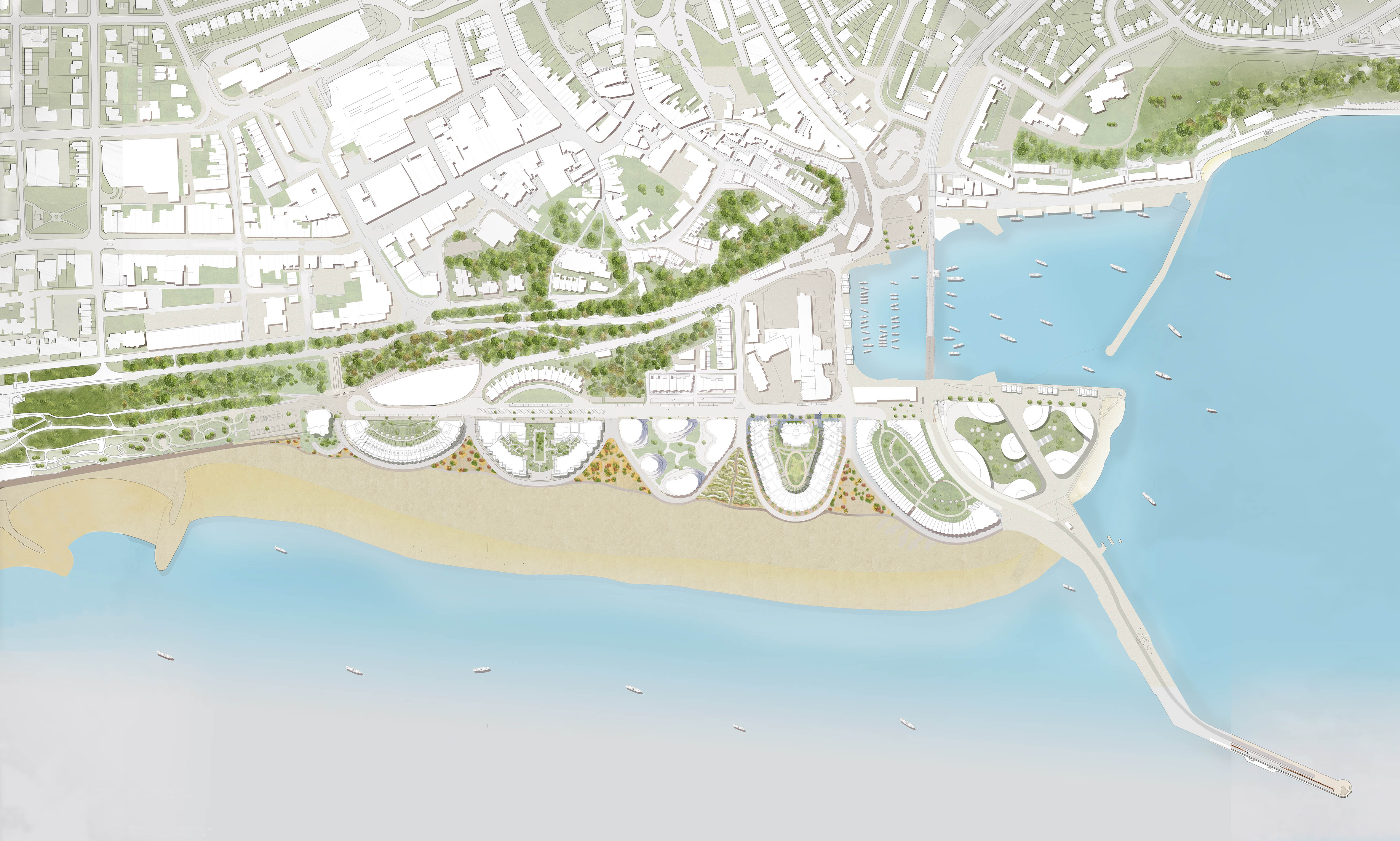
Folkestone Harbour and Seafront masterplan (source: ACME)
Folkestone is stern and patient in a way that is singular to the English seaside. It has been battered on the cold hard edge of the coast for centuries and picked up and dropped by Londoners in search of a day trip. Once nicknamed Fashionable Folkestone, it was brought to life by tourism and the arrival of the railways, then starved by a lack of it during the wars and by the arrival of cheap overseas travel in the ’60s and ’70s. German bombers would drop their left-over ordnance along this stretch of coast before heading home – a fitting descriptor for its plight. At the Harbour Arm Station, Tim Etchell’s 2014 Folkestone Triennial artwork Is Why The Place? acknowledges this history with two large neon signs saying ‘Coming And Going Is Why the Place Is There At All’. Things have changed since it was first installed in the once-ruined station, but it still nods both to Folkestone’s place as somewhere to be passed through, and to its cyclical history of decline.
Advertisement
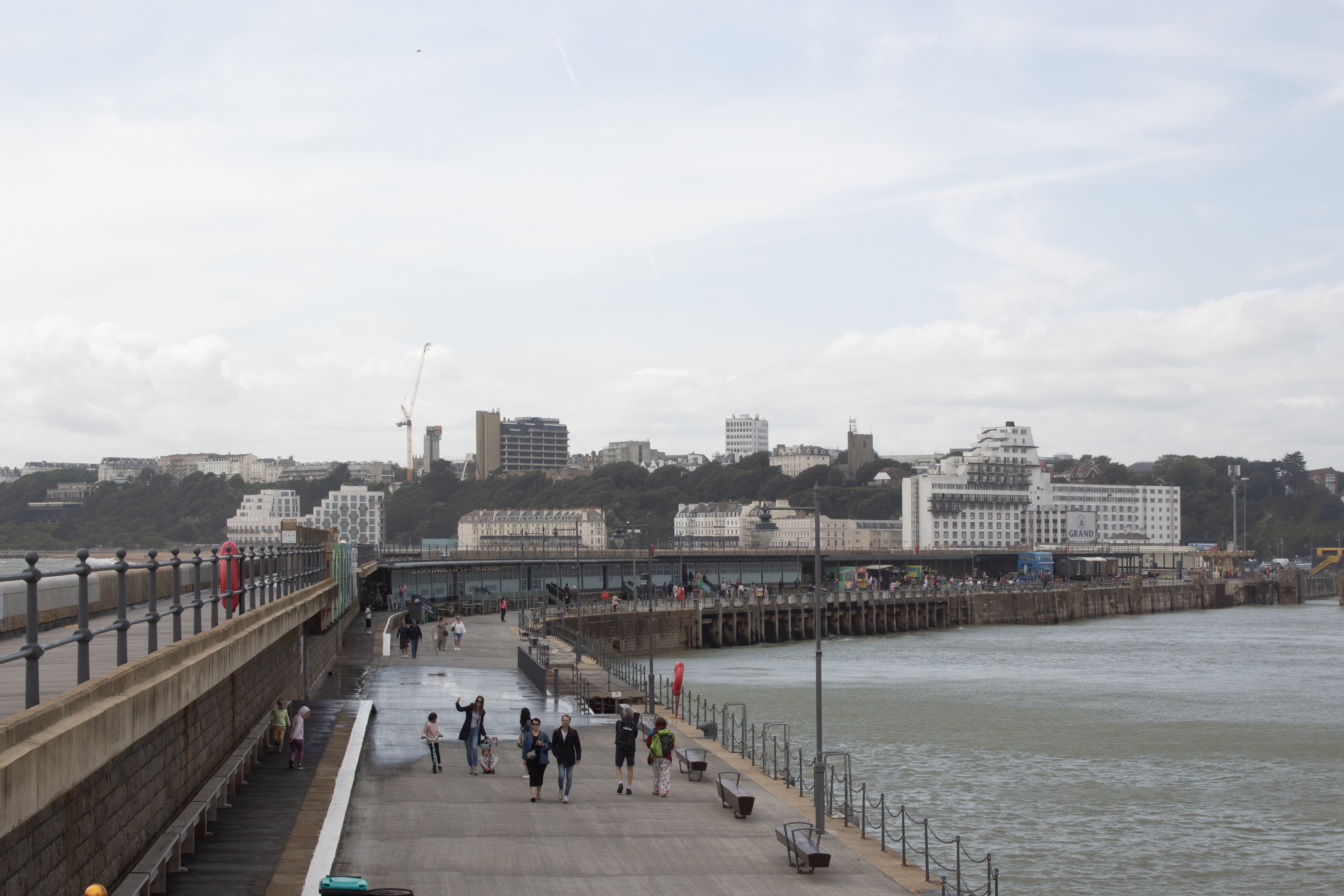
Folkestone Pier (source: Ellen Peirson)
ACME’s Shoreline Crescent is one project in a long line of plans, initiatives and buildings by a wealthy local benefactor, Roger De Haan, the former owner of Folkestone’s principal employer, Saga. In 2004 he sold the company and bought the harbour area, which had been left to decay since the opening of the Channel Tunnel spelt its closure. In 2006, De Haan bought the adjacent Rotunda amusements site from local business tycoon Jimmy Godden, after the latter’s plans to build a casino and seven-screen cinema on the site were abandoned. Godden was famous for his amusements empire along the east Kent coast, including Margate’s Dreamland.
Since 2002, separately under the Roger De Haan Charitable Trust (RDHCT), of which De Haan is chairman, he had also bought vacant properties in Folkestone’s Old High Street and Tontine Street. These were then leased to Creative Folkestone on peppercorn rents, and in turn offered to creatives as live-and-work spaces. The area was rebranded as the Creative Quarter and the first Folkestone Triennial arts festival followed in 2008. It has since produced the largest outdoor art collection in Europe.
Then came multiple masterplans for the area, produced by Foster + Partners, Farrells and, most recently, ACME for Folkestone Harbour and Seafront Development Company. This has so far seen the Harbour Arm brought back into active use as a food, drink and entertainment venue, the former Harbour Station preserved as a public garden and a larger beach and boardwalk created in place of the former Rotunda amusements park. Up to this point, it all involved gentle, incremental change and brought much-needed energy back into an area of Folkestone that was starved for decades.
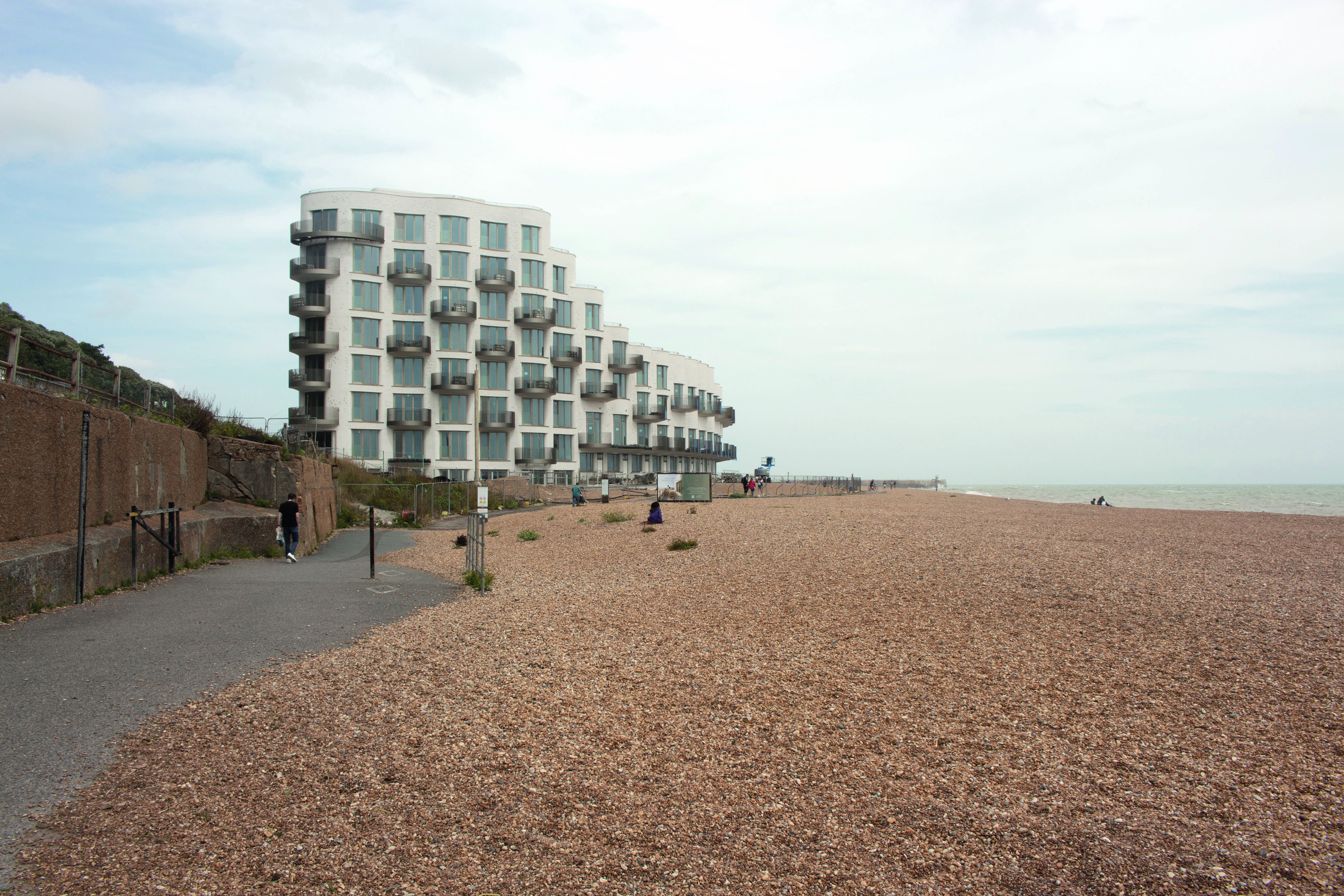
Shoreline Crescent facing onto the seafront (source: Ellen Peirson)
The aesthetic of ACME’s Shoreline Crescent follows an interesting lineage with respect to the history of a modernism unique to the coast, stemming from the more optimistic 1930s. Known variously as Seaside Moderne, Streamline Moderne or the Ocean Liner Style, it gave rise to playful buildings, created for leisure. With smooth lines, flowing curves and nautical portholes, it was diverse and brazen in a way that modernism further inland was not. Down the road from Shoreline Crescent, and the only taller building on the skyline, is the nine-storey, 550-room Grand Burstin Hotel, shaped like a cruise ship and determinedly pointed to France. It’s typical of the style, though poorly maintained and much maligned locally, and was completed in the 1980s just as cheap foreign travel put paid to domestic tourism. Currently just a banner stretches across where the hotel sign once was, after render fell away and hospitalised two people.
Shoreline Crescent has learnt from the harsh conditions that have taken their toll on the hotel – its materials are both robust against the weather and reflect its beauty. The façade ripples with Austral La Paloma white glazed bricks, some protruding at an angle. The play of light and colour on this coast inspired Spencer Finch’s 2011 Triennial artwork The Colour of Water, a wheel that sits on the clifftop above Shoreline Crescent which visitors can turn to match the ever-changing hues of the English Channel to colour swatches on its rim, describing perfectly what makes the horizon line so absorbing. This mutability is reflected too in the new building as it changes colour through the day.
Advertisement
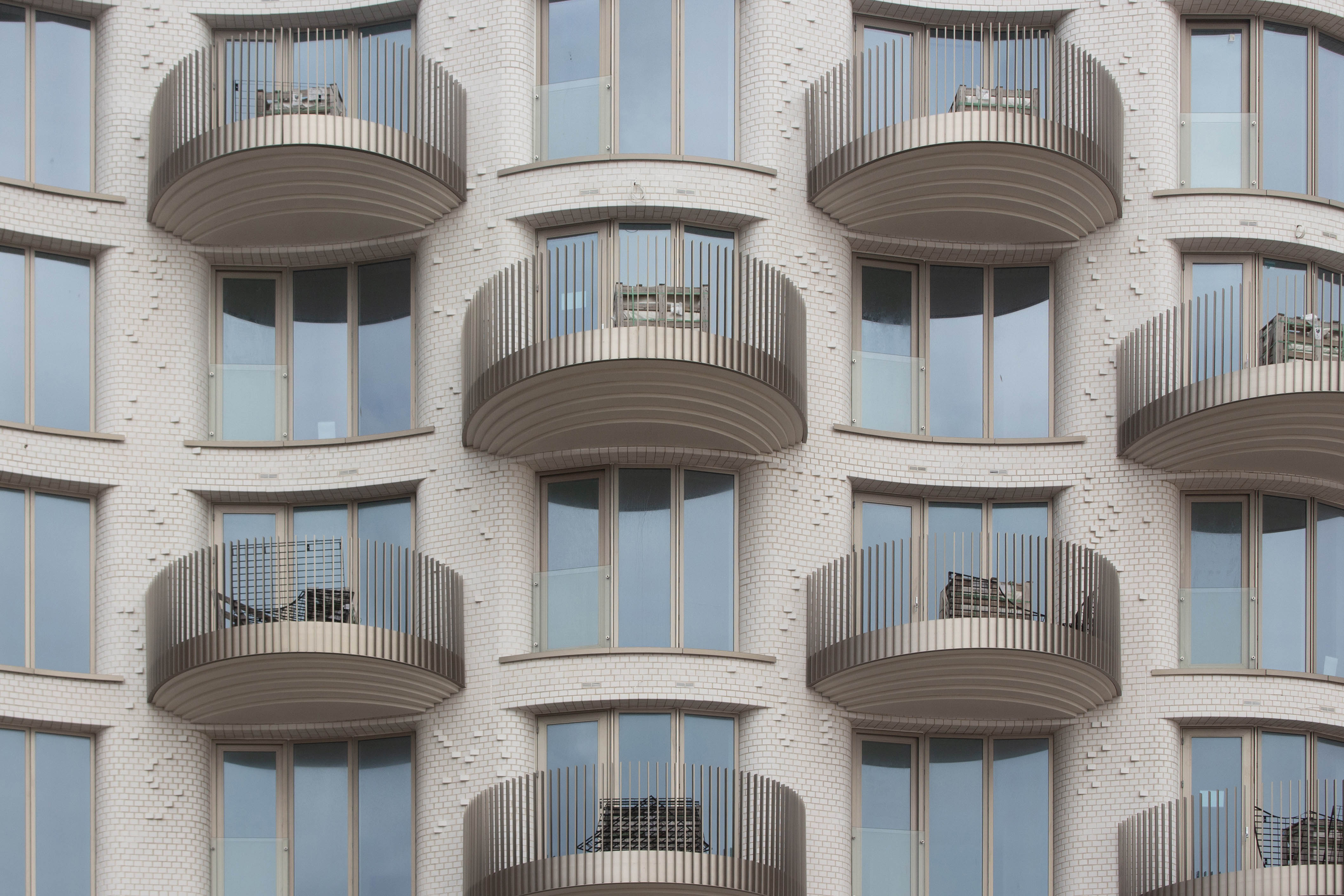
Rippling facade (source: Ellen Peirson)
The masonry’s wall ties are made from the same marine-grade stainless steel used on oil rigs, while railings and balustrades are fabricated from marine-grade powder-coated aluminium in a champagne colour that mixes with the hues of the shingle below. This gives the bolt-on balconies a solid feeling, helped by their granite-slab flooring. De Haan has lived on the seafront in Folkestone and says of his experience: ‘The winds are caustic; the blocks on the waterfront will be built to withstand that.’ Shoreline Crescent is built to last in its harsh, unforgiving marine environment and represents the client’s commitment to long-term change in the area. But, with its concrete frame and masses of durable metals to withstand the climate, Shoreline Crescent’s construction is carbon-intensive. Its podium car park meanwhile presents a car-orientated lifestyle, creating a harsh and unwelcoming street scene of louvred wall along the development’s northern edge.
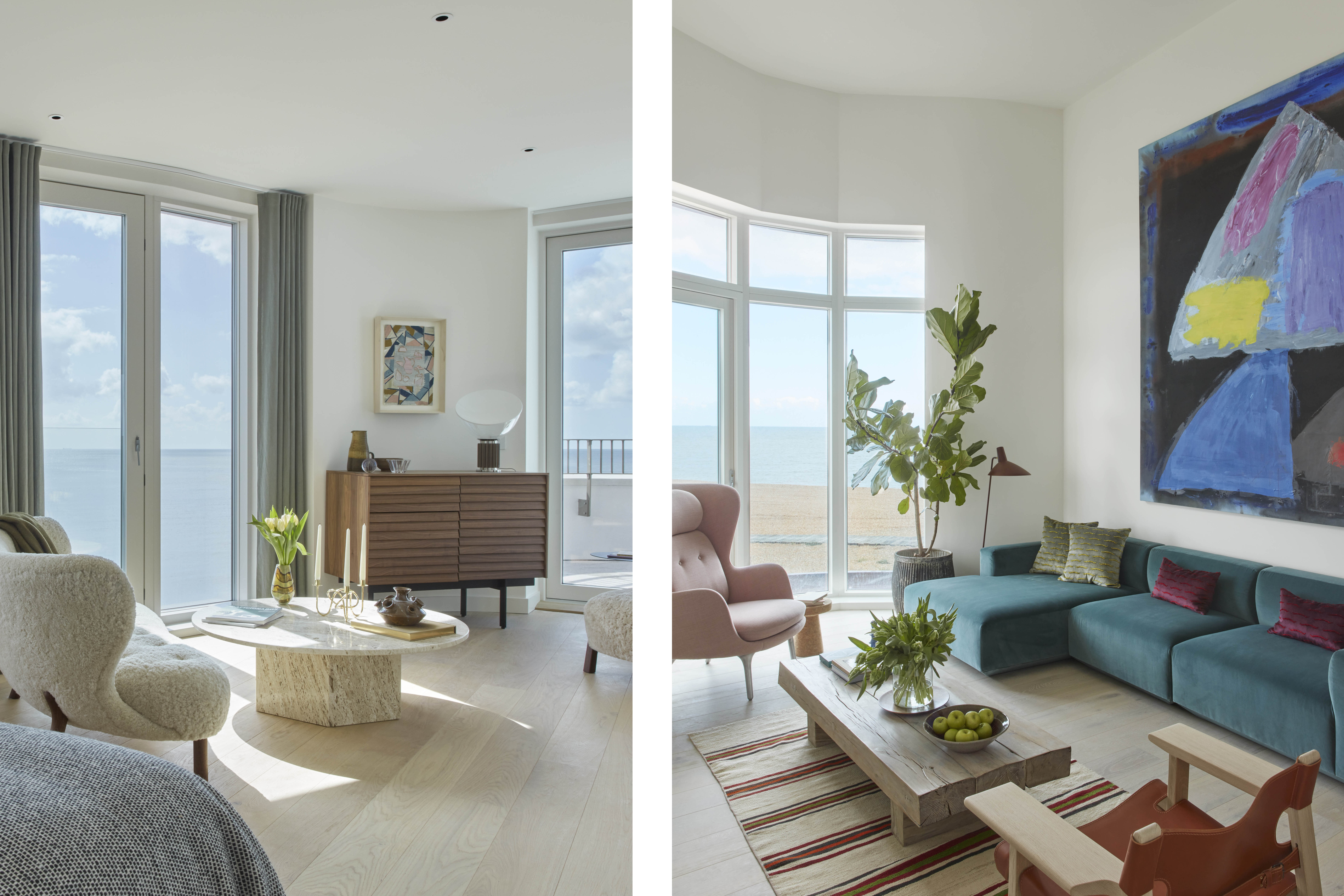
Interior living spaces (source: James McDonald)
Shoreline Crescent is the first block to be completed of several in the Harbour and Seafront masterplan and its waterfront apartments – one to four-bed apartments and townhouses – are now being released onto the market. It sits in a quiet, open landscape. The perpetual hum and lights of the Rotunda amusement park have given way to the natural beauty of an open, unconstrained beach. Soon the area will be transformed again – the next stage of the development will see 81,000m2 of residential and 11,000m2 of commercial space built on the Harbour Arm car park and adjacent reclaimed beach, as well as the reopening of the Leas Lift, the funicular railway behind Shoreline Crescent.
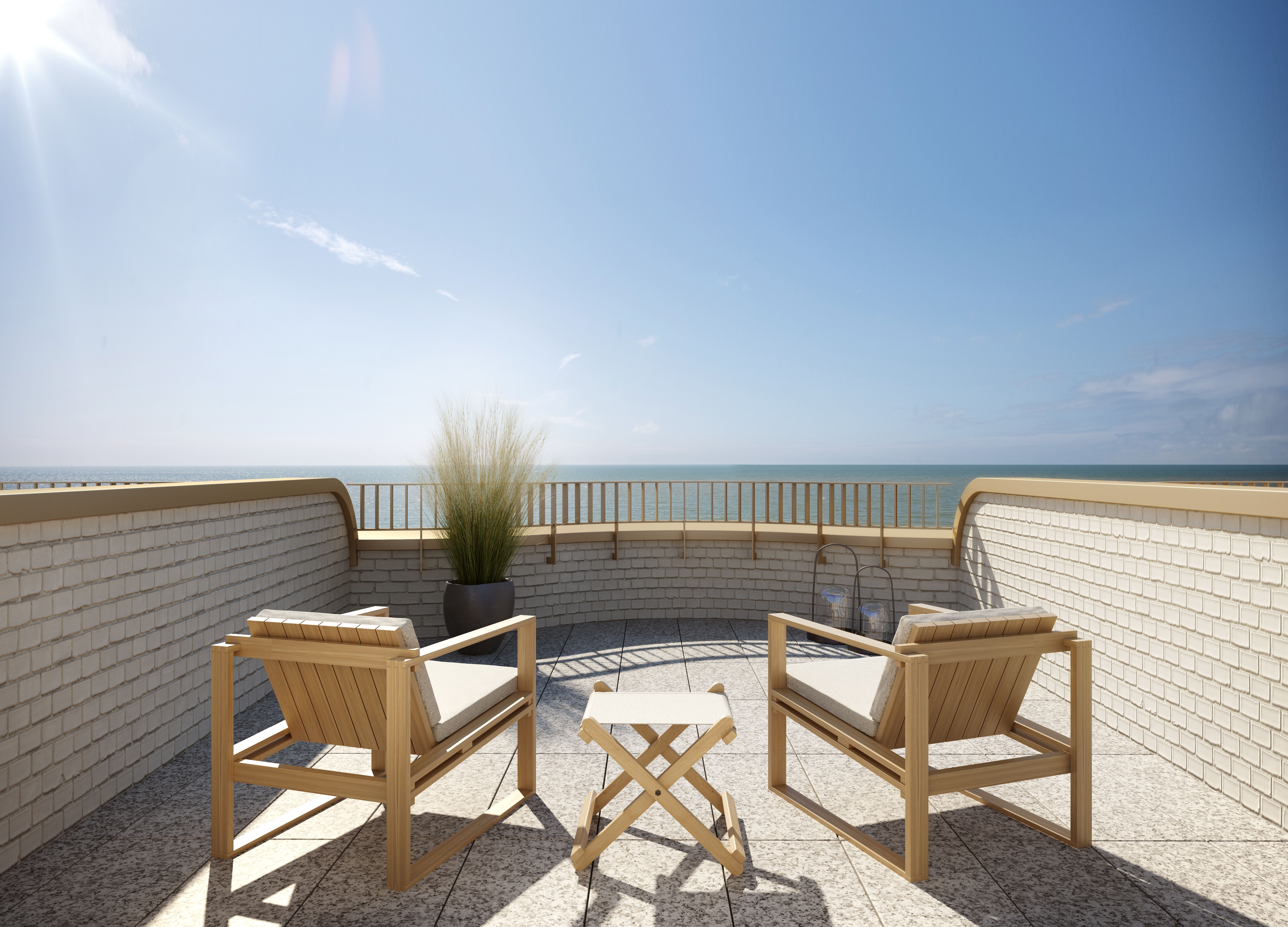
Townhouse roof terrace (source: James McDonald)
The central crescent shape that gives the block its name is bookended by taller six-storey elements to the east and west containing one- and two-bed apartments, while the crescent itself contains four two-bedroom duplexes, and 20 three and four-bedroom townhouses. The 19th-century Marine Crescent next door curves itself around the sea stretching out in front of it, but Shoreline Crescent turns its back so that the design shelters the communal garden. On the beach side, this gives the townhouses front doors that open onto the waterside, and small back gardens that roll into a larger, shared space sheltered from the strong winds that the beach receives year-round. Under the masterplan, the development will move its way eastwards, ending at the Harbour Arm, where commercial units will house the traders currently operating out of shipping containers and huts, and the old station will be reimagined again as a high street of shops.
The total development will provide 1,000 new homes. Of these, 8 per cent will be designated affordable, under shared ownership, falling well short of the 22 per cent target in the Local Plan. This will be a dense neighbourhood and it’s unclear whether the area will be able to support it, as evidenced by the developer-client’s own hesitancies in the market – De Haan admits that future blocks could be adapted, based on market response. Little of Folkestone’s past can be recognised in the development, which encloses space that, if not fully ‘public’, the public had come to know as theirs. And, at prices more typical of London, local residents will see little of themselves in Shoreline Crescent.
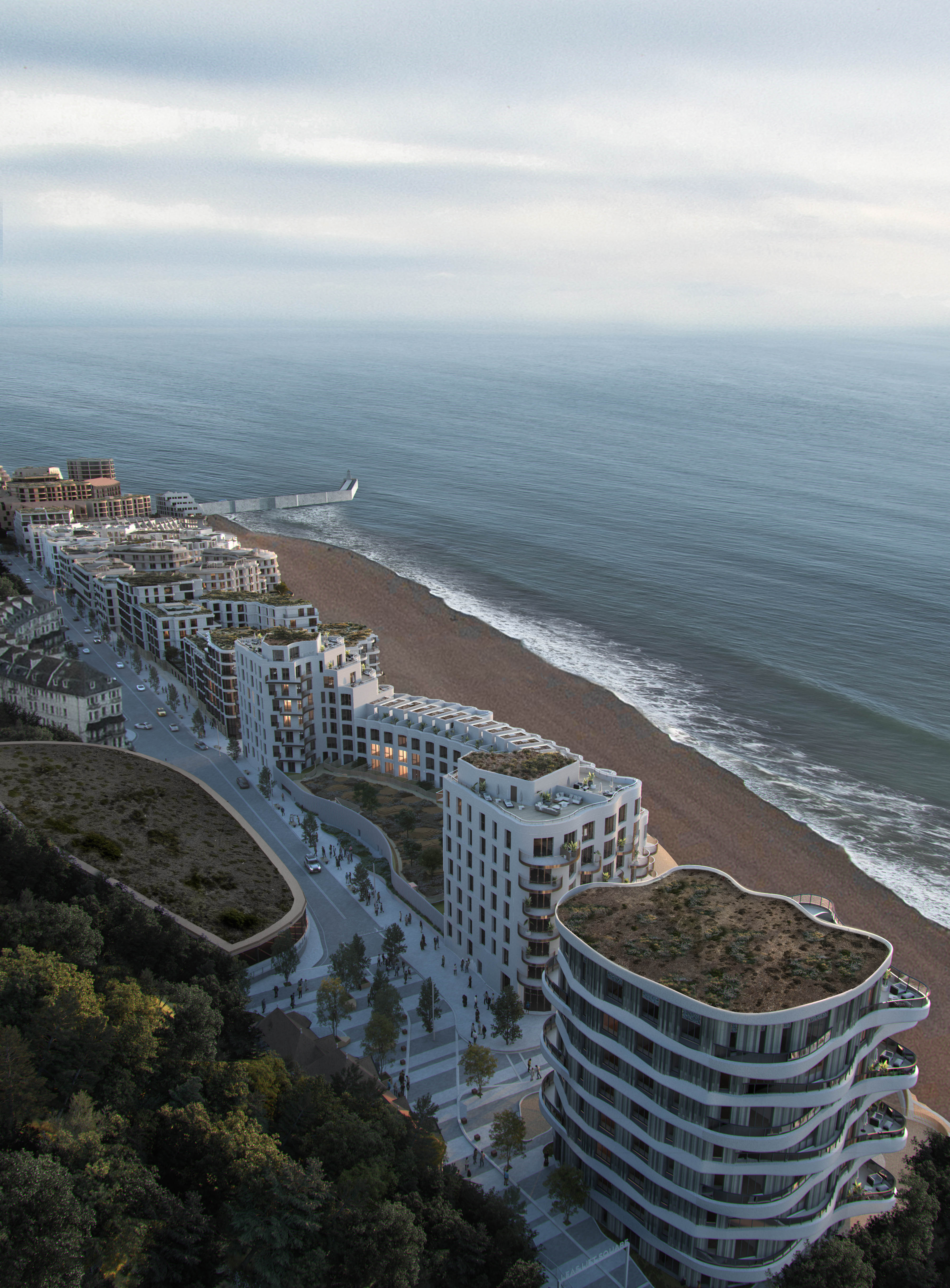
Proposed visualisation of seafront development in context (source: Pixelflakes)
Of the community the developers are hoping to create here, De Haan says: ‘I’ve been accused of gentrifying Folkestone, which I think is unfair.If I were buying up modest buildings in Islington, doing them up and putting swimming pools in the basements, no one would care.’ It’s a tricky thing to do, to integrate a new community, invited either for their wealth or artistic inclinations, into an existing one that has experienced decades of decline. The subtext to this story, whether it’s considered regeneration or gentrification, is that the old Folkestone was the problem, and this new Folkestone is the solution.
For the 2017 arts Triennial, a series of cartoon bungalows popped up around the town. One was perched on the beach, next to where Shoreline Crescent sits now, apparently half-subsiding into the shingle. It was one of six works by artist Richard Woods titled Holiday Home, representing how communities have second homes imposed upon them in the most inconvenient or unlikely of places, an example of many Triennial artworks that have addressed issues around Folkestone’s ongoing regeneration. De Haan is aware of these and says: ‘We want to attract people who will spend most of their time here.’ He has backed this up by placing a covenant on all the units so they cannot be rented out as Airbnbs – a remarkable commitment given the area’s history of tourism. De Haan goes on to describe how at the Folkestone Academy, 10 or more years ago, careers advisers were seeing students doing their best to get out of the town. ‘Now they all want jobs in the town,’ he says. Still, there are reasons to be less optimistic. In December 2022, Folkestone’s 135-year-old library was forced to close due to flooding and the local council could not afford the £1.8 million repair bill. De Haan describes this as devastating, and while approximately £80,000 of his £9.6 million Section 106 agreement will go towards library funding in the town, the grim truth is that the sale of just one penthouse apartment would go a long way towards paying to reopen the library. This is not De Haan’s responsibility, and he has put more time, energy and money into the town over the decades than anyone, but it does not convince local people that Folkestone isn’t becoming a tale of two towns: the luxury apartments on the seafront and boutique shops on the Old High Street, and the closure and inadequacy of public services in the rest of the town where other commercial streets are full of struggling shops.
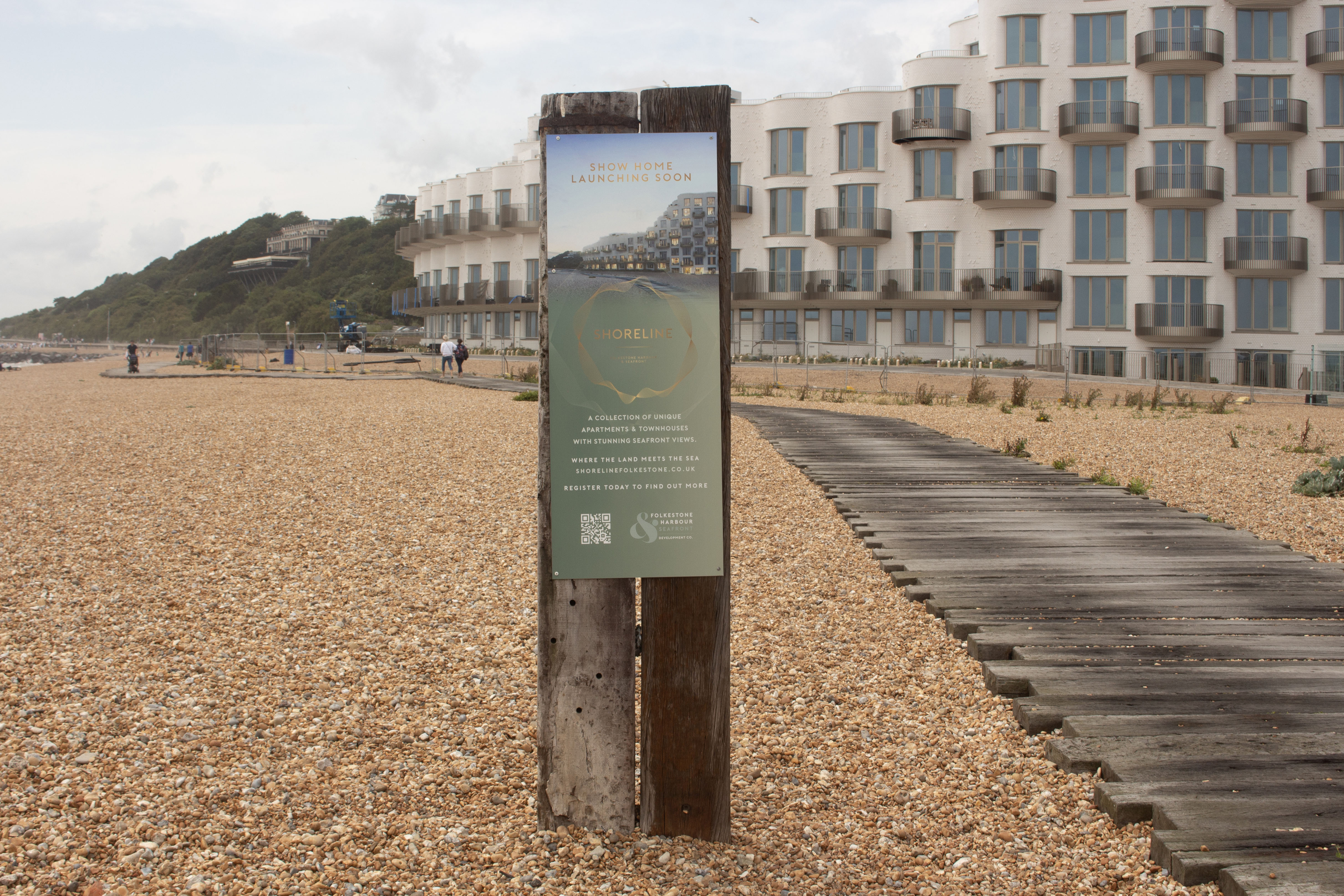
View of first phase from seafront with advertising board (source: Ellen Peirson)
There’s a saying in Folkestone: ‘Blood flows more calmly in the town of Harvey’. Samuel Beckett wrote it on a postcard while laying low there and sent it to artist Avigdor Arikha in Paris. It’s a reference to the town having been home to William Harvey, who discovered blood circulation in the 17th century, and a comment on its perceived stillness. From the penthouse terrace of Shoreline Crescent, Folkestone stretches placidly out before you, as it seems to have done for Beckett, but behind the calm a furore simmers as public consultations continue for detailed planning applications of the remaining plots. One resident describes it as ‘rampant overdevelopment’. More often, Folkestone has been anything but Beckett’s calm town, its steady tides are cold and relentless, and it is against this social and economic background that some local people are mistrustful of both Shoreline Crescent and the unfolding masterplan.
Ellen Peirson is a writer and architectural assistant at Mike Tuck Studio
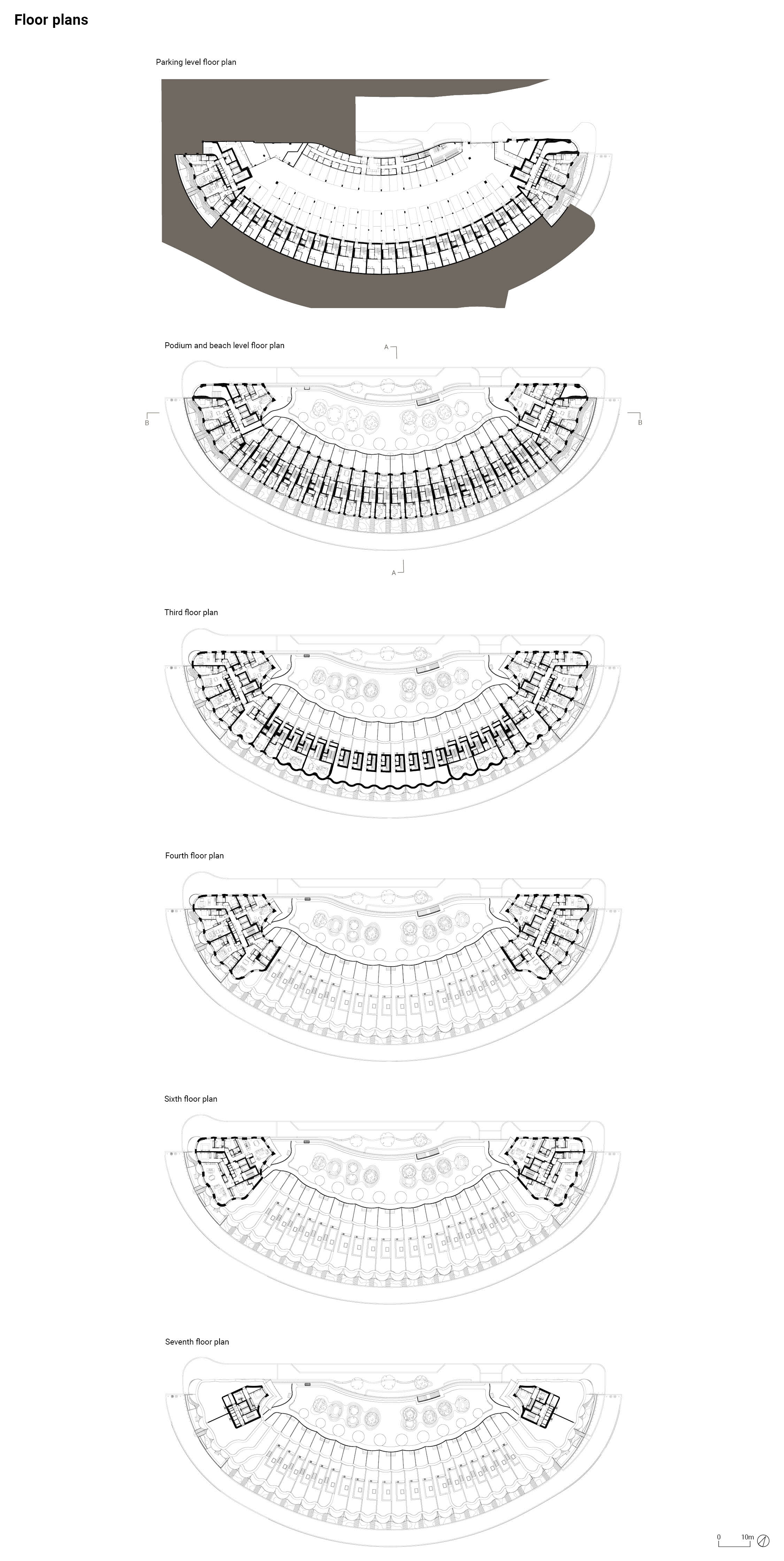
Architect’s view
This is a one-of-a-kind building, offering different layouts to fit a wide range of ambiences, showing various types of duplexes, townhouses and apartments, all with stunning views. It is the result of an intense co-ordination effort by all parties to deliver it within the otherwise standard time and budget constraints. Multiple strategies had to be adopted to provide the MEP services to every unit.
It is rich in bespoke details tailored to fit its sinuous shapes, such as the custom-made glazed bricks, windows, balconies, sills, railings, precast stairs and fin. Some of these had to be site-surveyed with laser measurements to ensure the customised elements would fit the building’s unique shapes, adding an extra layer of complexity into the process between the different interfaces.
Joao Bras, project architect, ACME
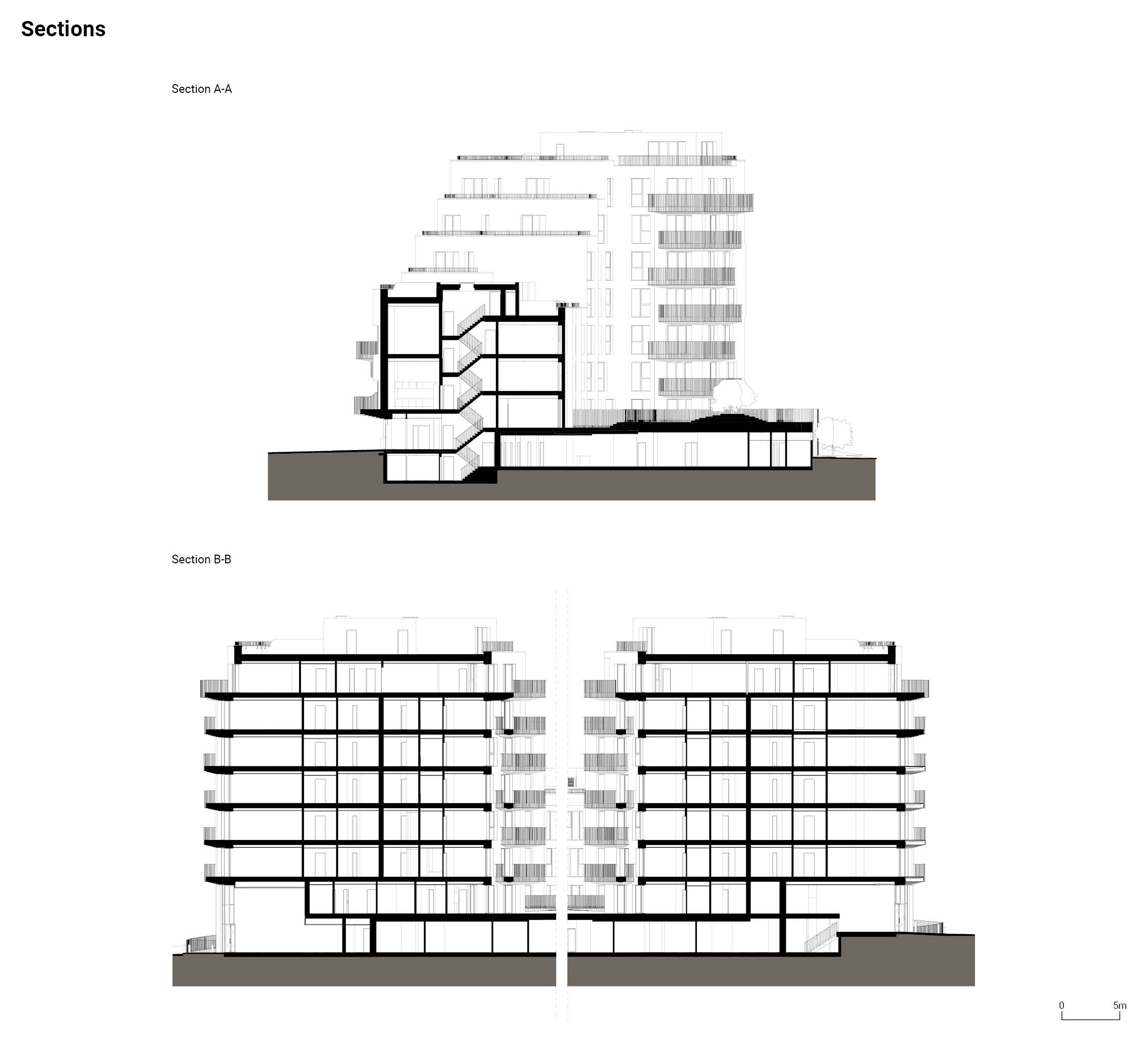
Client’s view
Shoreline Crescent (Plot B1) is the first plot within the Folkestone Harbour and Seafront Development to be constructed, part of a wider masterplan that will eventually see the delivery of up to 1,000 new homes and mixed-use space.
The building was designed to be highly sustainable and incorporates building fabric with a high thermal efficiency and high levels of airtightness. All homes are fitted with the latest technology and systems to make them as efficient as possible, while high-performance windows and doors, as well as solar control glazing in specific locations across the building (identified through thermal modelling analysis), prevent overheating and provide high levels of insulation.
A key part of the brief was to ensure that the external materials selected for the project were sustainably sourced and specified for their extremely durable, long-lasting and low maintenance characteristics, due to the building’s position facing onto the open sea. Marine-grade stainless steel, anodised aluminium, terrazzo, glazed bricks and Accoya are all used in the external palette. The deployment and use of these materials is technically challenging. One example is the façade, which is constructed of low-porosity glazed bricks. Each brick was made specifically for this project – shorter than a standard brick to achieve the tight curves of the building. A key success of the project has been the combination of specialist, bespoke and off-site manufacturing techniques that have helped to ensure a high-quality finish, using local skilled tradespeople to install the components and materials – all of which contributed to a significant reduction in the project’s carbon footprint during the build process.
Roger De Haan, chair, Roger De Haan Charitable Trust
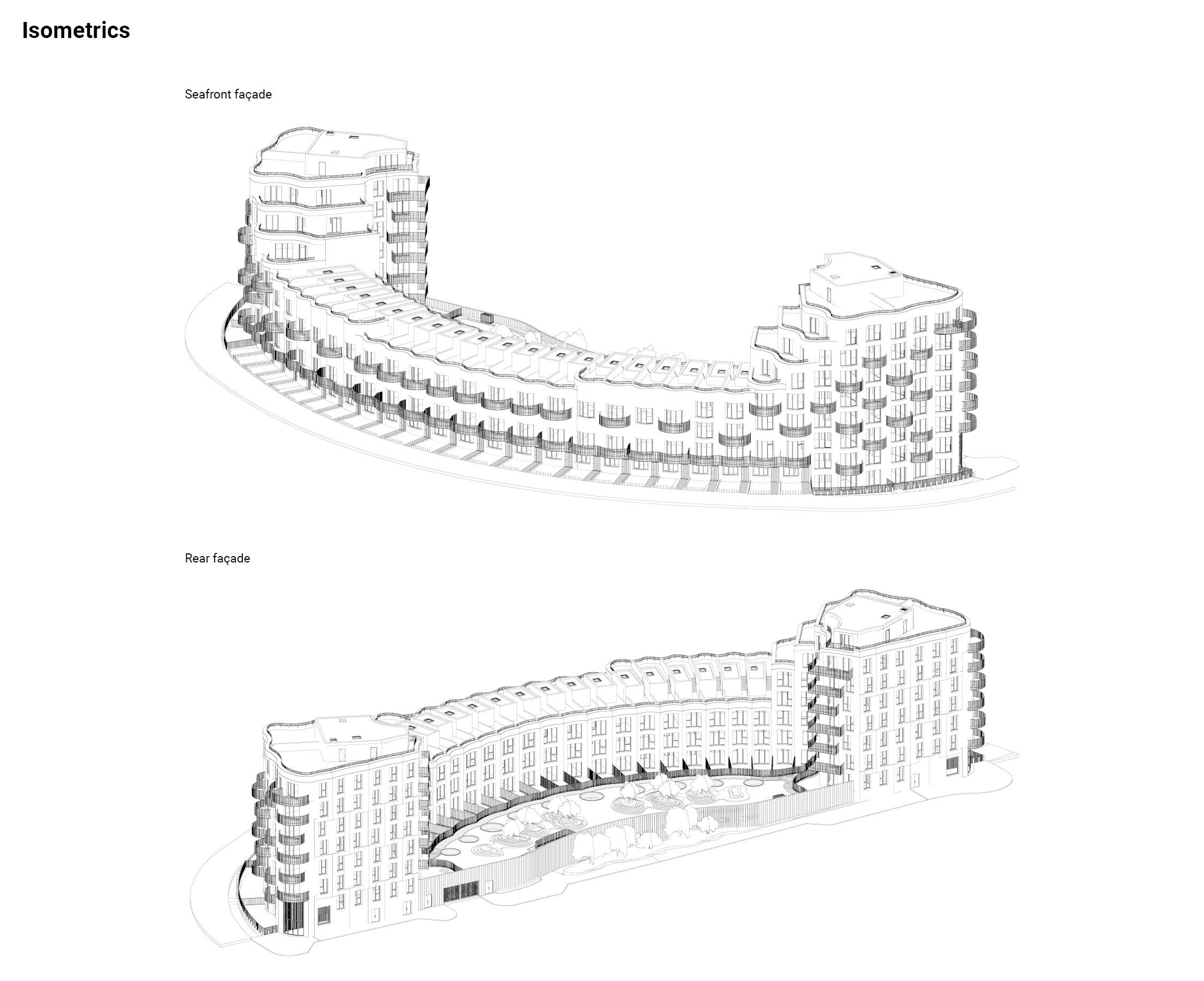
Specialists' views
Shoreline Crescent has two distinct micro-climates, one created by the harsh sea winds and a second from the shelter formed by the crescent-shaped building. These contrasting conditions allow the landscape to have two very different characters, informed by distinct planting types and design language. On the beach and in the adjacent Shingle Garden, linear shingle dunes planted with colonising native species, such as those found along Folkestone Beach, offer protection from south-westerly winds. The front gardens take on this same beach character.
The residents’ podium garden is sheltered, lush and vibrant, informed by the same Mediterranean planting found in the Lower Leas Coastal Park. Due to the sheltered nature of the podium, mounds and forms become loose, free and informal.
Rosie Sargen, project lead, Spacehub
We responded to the dynamism of Folkestone and the spectacular location to create sophisticated, comfortable living spaces, drawing on the landscape, architectural details and Scandinavian design.
Tobias Vernon, founder, 8 Holland Street
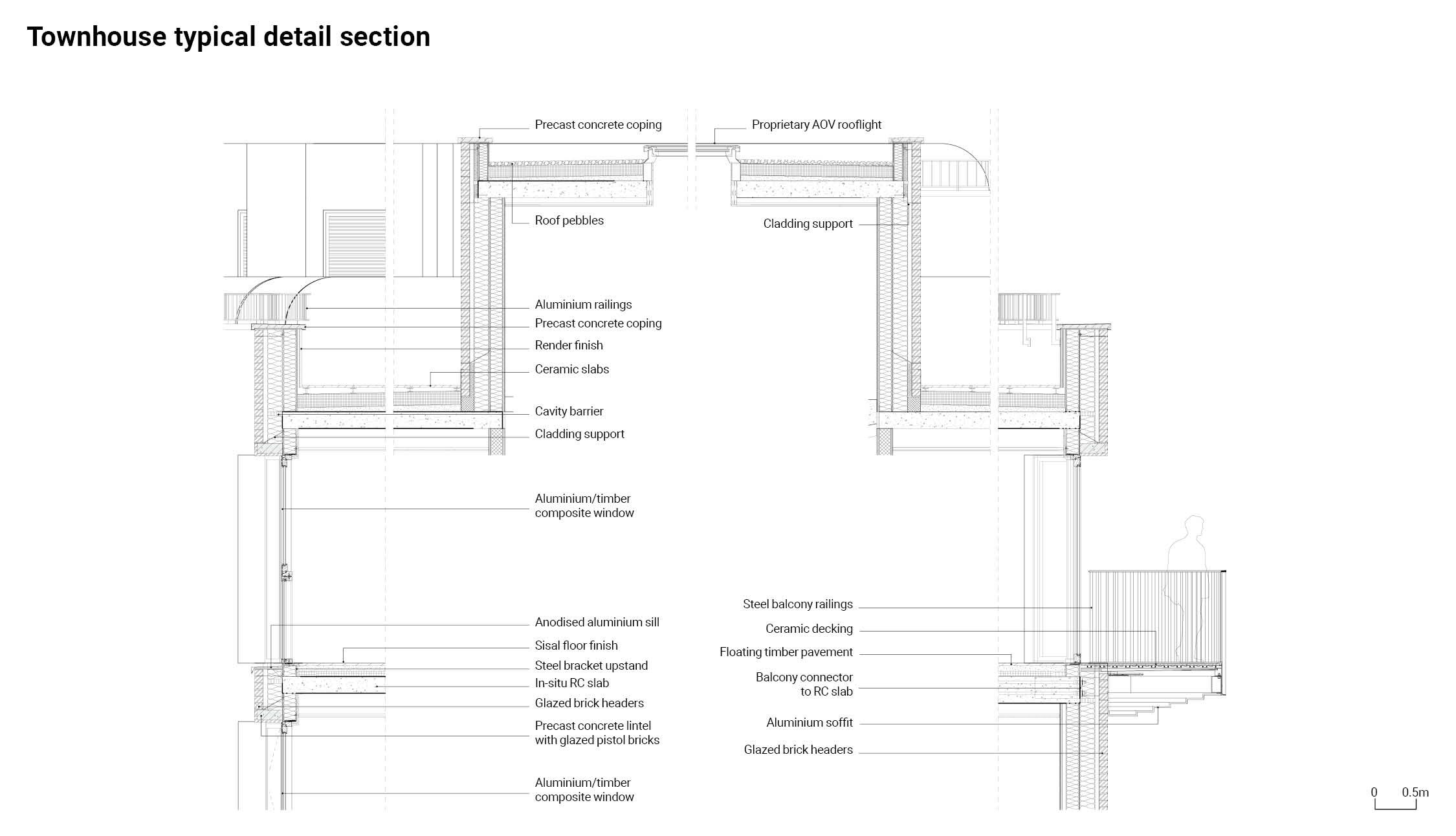
Working detail
Shoreline Crescent’s layout and architectural language pay homage to Regency buildings at the top of the Leas. Its form is a large sweeping crescent offering stunning sea views to as many of its homes as possible.
The building contains 20 townhouses, four duplexes and two apartment blocks with 30 apartments each. The crescent sits directly on a raised part of the beach, and the semi-circular massing is used to frame a sheltered communal garden away from the prevailing south-easterly winds.
The unique, contemporary design is created with materials and robust details required for the seafront exposure. The white glazed bricks, sourced from Spain, refer back to the white stucco Regency houses. The crafted façade acts as a ‘hard shell’ with all external elements of the highest specification possible to withstand the marine environment. The bricks were carefully crafted and cut to help curve the gentle contours of the buildings. Over 28 brick specials have been utilised. The result is a glistening façade that reflects the sun and sea, changing with local weather patterns. A playful interpretation of the clinker brick sits within the concave rhythms of the south façade, where individual shaped bricks are pulled forward to create interest and animation.
The seafront building is rich in bespoke details tailored to fit its sinuous shapes. Townhouses and apartments share a common language of bay windows, balconies and roof terraces. Internally, the block contains a diverse range of residential typologies, from simple townhouses and apartments to interlocking units with alternating panoramic views of the sea.
James Denner, director, ACME
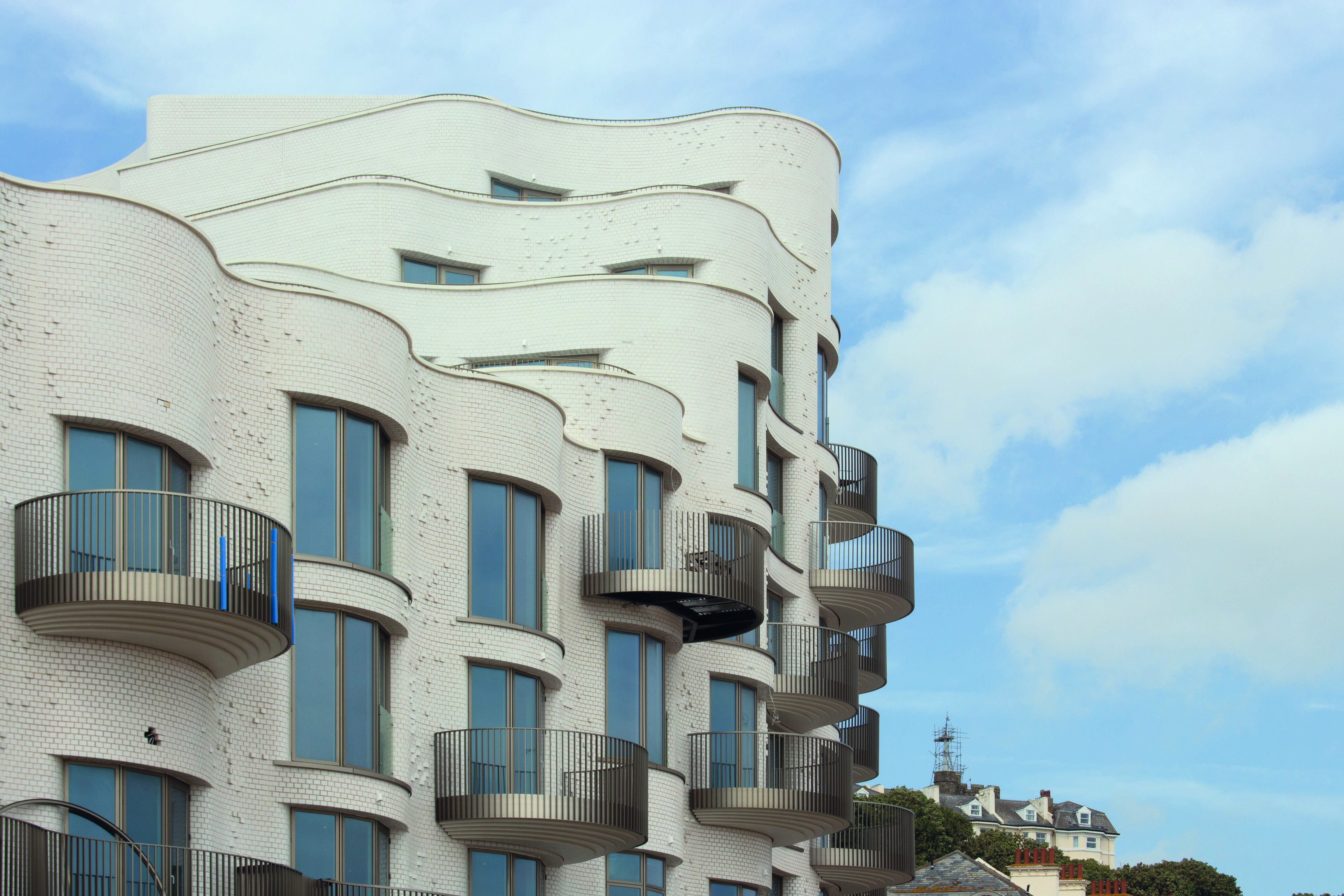
(source: Ellen Pierson)
Project data
Start on site May 2020
Completion September 2023
Gross internal floor area 12,310m2
Construction cost Undisclosed
Architect ACME
Client Folkestone Harbour Seafront Development Company
Structural engineer Buro Happold
M&E consultant Buro Happold
Quantity surveyor Betteridge & Milsom
Project manager Spider
Principal designer ACME
Approved building inspector MLM
Civil engineer Buro Happold/Pell Frischmann
Interior designer 8 Holland Street
Landscape architect Spacehub
Main contractor Jenner
CAD software used Revit
Sustainability data
Percentage of floor area with daylight factor >2%/>5% Not supplied
On-site energy generation Not supplied
Heating and hot water load Not supplied
Total energy load 45.7 kWh/m2/yr
Carbon emissions (all) Not supplied
Annual mains water consumption Not supplied | Airtightness at 50Pa 3 m3/hr/m2
Overall thermal bridging heat transfer coefficient (Y-value) 0.15 W/m2K
Overall area-weighted U-value Not supplied
Embodied / whole-life carbon 583 kgCO2eq/m2
Predicted design life 60+ years
 The Architects’ Journal Architecture News & Buildings
The Architects’ Journal Architecture News & Buildings
Excellent article